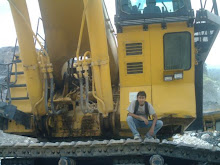Calm excitement filled the ground control station. Engineers stared intently at their computer screens as the pilot, sitting next to them, flexed his fingers on the controls. Ground crew tending the aircraft finished putting away their equipment. Preparations for the first flight of the unmanned X-48B Blended Wing Body research aircraft were complete.
Years of research, design, construction, wind tunnel and ground tests coalesced into this one moment of time.
Radios crackled. "Tower, Skyray 48 in position, lakebed runway 23, request clearance for takeoff..."
"Skyray 48 roger, main base winds 220 at 6, report airborne, lakebed 23..."
"Wilco"
"Five, four, three, two, one, brakes..."
Quickly, the manta ray-shaped aircraft rolled down the dry lakebed runway trailing a plume of dust as it picked up speed, its three small jet engines whining.
With an excitement that only comes with an aircraft's first flight, the triangular red, white and blue X-48B leapt into the air, obviously wanting to fly.
"Skyray 48's airborne," Boeing pilot Norm Howell called, matter-of-factly. And with that, years of toil blossomed into the sweet fruit of success on July 20, 2007 at NASA's Dryden Flight Research Center on Edwards AFB, Calif.
One of the latest cutting-edge experimental aircraft, or X-Planes, the X-48B BWB is a collaborative effort of the Boeing Co., NASA's Fundamental Aeronautics Program, and the Air Force Research Laboratory. The 21-foot wingspan, 500-pound, remotely piloted plane is designed to demonstrate the viability of the blended wing shape. And demonstrate it has.
After completion of six flights, the X-48B team began a four-week maintenance and modification period during which removable leading edges with extended slats are being replaced with slatless leading edges in order to mimic a slats-retracted configuration. The change requires a software update to the flight control software. In addition, the team is removing and replacing all of the aircraft's flight control actuators for maintenance purposes.
NASA is interested in the potential benefits of the aircraft - increased volume for carrying capacity, efficient aerodynamics for reduced fuel burn, and, possibly, significant reductions in noise due to propulsion integration options. In these initial flights, the principal focus is to validate prior research on the aerodynamic performance and controllability of the shape, including comparisons of flight test data with the extensive database gathered in the wind tunnels at NASA's Langley Research Center in Virginia.
The Subsonic Fixed-Wing Project, part of NASA's Fundamental Aeronautics Program, has long supported the development of the blended wing body concept. It has participated in numerous collaborations with Boeing, as well as several wind tunnel tests for different speed regimes. The team is focused on researching the low-speed characteristics of the design and expanding its flight envelope beyond the limits of current capabilities.
In addition to hosting the X-48B flight test and research activities, NASA Dryden is providing engineering and technical support -- expertise garnered from years of operating cutting-edge air vehicles. NASA assists with the hardware and software validation and verification process, the integration and testing of the aircraft systems, and the pilot's ground control station. NASA's range group provides critical telemetry and command and control communications during the flight, while the flight operations group provides a T-34 chase aircraft and essential flight scheduling. Photo and video support complete the effort.
The composite-skinned, 8.5 percent scale vehicle can to fly up to 10,000 feet and 120 knots in its low-speed configuration. The aircraft is flown remotely from a ground control station by a pilot using conventional aircraft controls and instrumentation, while looking at a monitor fed by a forward-looking camera on the aircraft.
Up to 25 flights are planned to gather data in these low-speed flight regimes. Then, the X-48B may be used to test the aircraft's low-noise and handling characteristics at transonic speeds.
Two X-48B research vehicles were built by Cranfield Aerospace Ltd., in England, in accordance with Boeing specifications. The vehicle that flew on July 20, known as Ship 2, was also used for ground and taxi testing. Ship 1, a duplicate, was used for the wind tunnel tests. Ship 1 is available for use as a backup during the flight test program.
So far, so good as the Skyray 48 team works through the late summer heat of the Mojave Desert as they continue blazing a trail with this futuristic aircraft design. Oleh:sciencedaily





0 komentar:
Posting Komentar